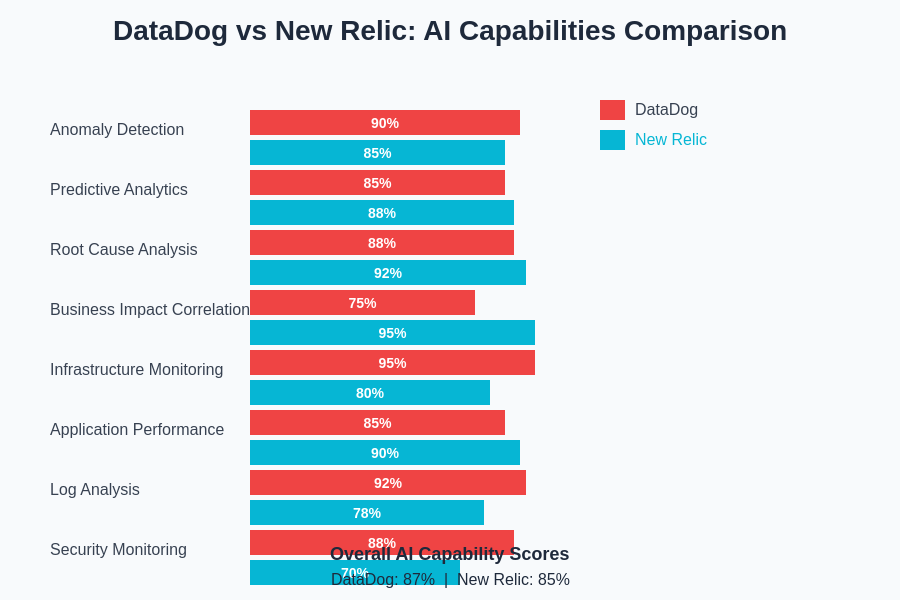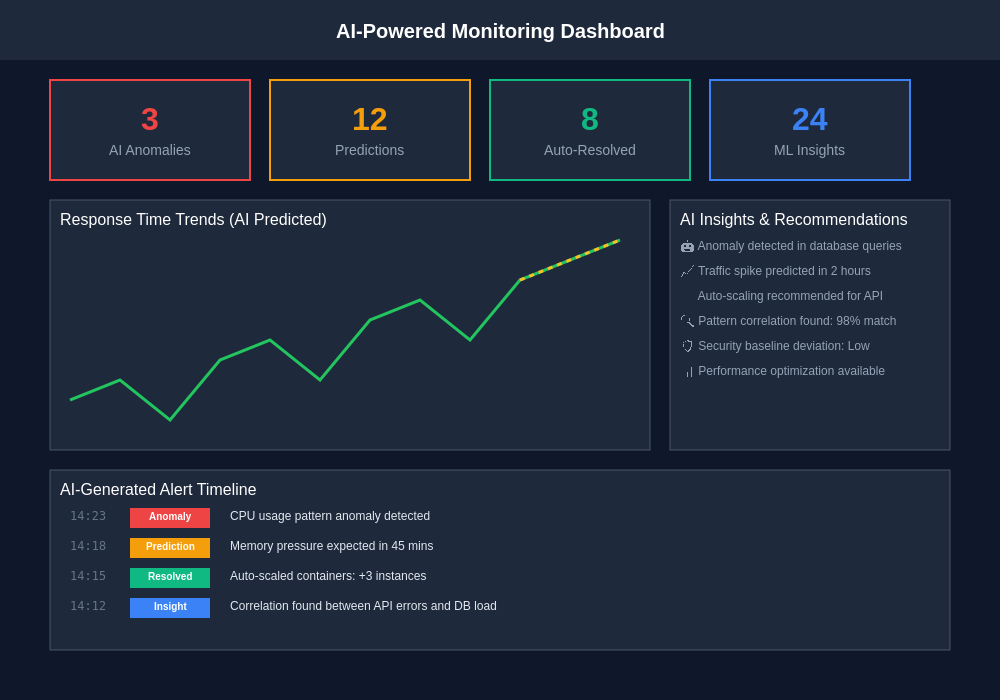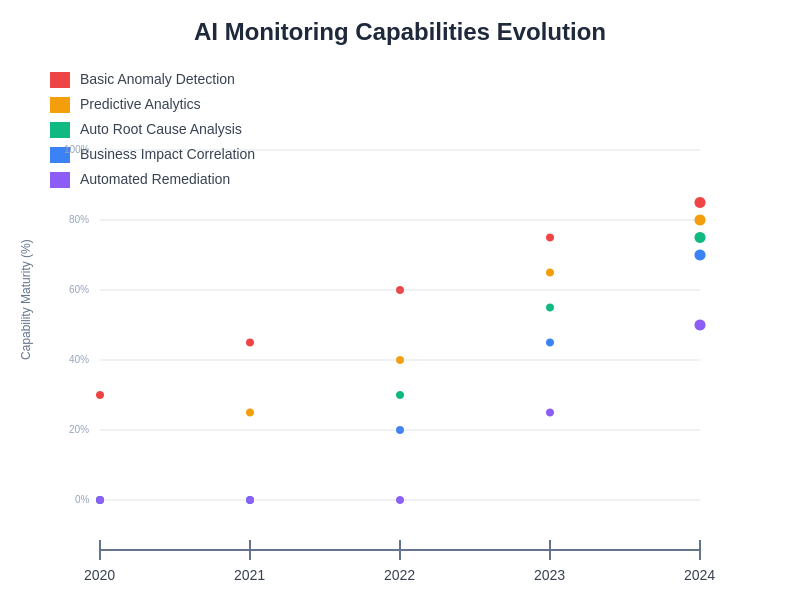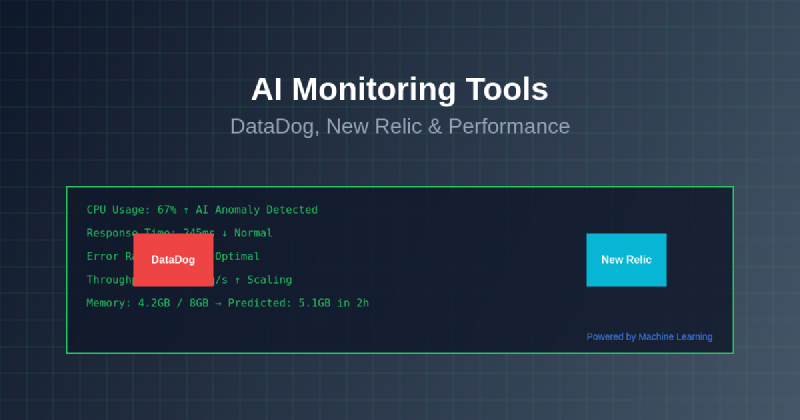The evolution of application monitoring has reached an inflection point where artificial intelligence and machine learning fundamentally reshape how organizations observe, analyze, and optimize their digital infrastructure. Modern AI-powered monitoring platforms like DataDog and New Relic represent the vanguard of this transformation, delivering unprecedented capabilities in anomaly detection, predictive analytics, and automated root cause analysis that traditional monitoring solutions simply cannot match.
Stay updated with the latest AI monitoring trends to understand how artificial intelligence continues to revolutionize observability and performance management across enterprise environments. The integration of AI into monitoring workflows has transcended simple metric collection, evolving into sophisticated systems that can predict failures, automatically correlate incidents across distributed architectures, and provide actionable insights that enable proactive rather than reactive operational strategies.
The AI Revolution in Application Performance Monitoring
Traditional application performance monitoring relied heavily on static thresholds, manual correlation of events, and reactive approaches to incident response. The introduction of artificial intelligence has fundamentally transformed this paradigm by enabling systems to learn normal behavioral patterns, identify subtle anomalies that would escape human detection, and automatically adapt monitoring strategies based on changing application dynamics and infrastructure conditions.
Modern AI-powered monitoring platforms leverage sophisticated machine learning algorithms to process vast quantities of telemetry data from distributed systems, microservices architectures, and cloud-native applications. These platforms can analyze millions of data points in real-time, identifying patterns and correlations that would be impossible for human operators to detect manually. The result is a monitoring ecosystem that not only tells you what happened but predicts what might happen and automatically suggests or implements remediation strategies.
The shift toward AI-driven observability has enabled organizations to move from reactive firefighting to proactive optimization, reducing mean time to resolution for incidents while simultaneously improving overall system reliability and performance. This transformation has become particularly crucial as applications have become increasingly complex, distributed across multiple cloud environments, and subject to rapidly changing user demands and traffic patterns.
DataDog: Comprehensive AI-Powered Observability Platform
DataDog has established itself as a leader in the AI-powered monitoring space by integrating machine learning capabilities throughout its comprehensive observability platform. The platform’s AI-driven approach encompasses everything from automated anomaly detection and intelligent alerting to predictive capacity planning and automated root cause analysis, creating a unified monitoring ecosystem that scales with organizational complexity.
The platform’s anomaly detection capabilities utilize sophisticated statistical models and machine learning algorithms to establish dynamic baselines for application performance metrics. Unlike traditional static threshold-based alerting, DataDog’s AI system continuously learns from historical data patterns, seasonal variations, and contextual information to identify deviations that truly indicate potential issues rather than normal operational variations.
DataDog’s Watchdog feature represents one of the most advanced implementations of AI in monitoring, automatically detecting anomalies across infrastructure, applications, and logs without requiring manual configuration. The system can identify performance degradations, error rate spikes, and resource utilization anomalies across complex distributed systems, providing detailed context about potential root causes and suggested remediation strategies.
The platform’s AI-powered correlation engine can automatically connect related incidents across different services and infrastructure components, significantly reducing the time required to understand the scope and impact of issues. This capability has proven particularly valuable in microservices environments where a single user-facing issue might stem from problems in multiple underlying services or infrastructure components.
Experience advanced AI capabilities with Claude for enhanced monitoring strategy development and intelligent analysis of complex observability data patterns. The integration of AI assistants with monitoring platforms creates new possibilities for automated incident response and proactive system optimization.
New Relic: AI-Driven Application Intelligence
New Relic has positioned itself at the forefront of AI-driven application intelligence, leveraging machine learning and artificial intelligence to provide deep insights into application performance, user experience, and business impact. The platform’s AI capabilities extend beyond traditional monitoring to include intelligent business metrics correlation, automated performance optimization suggestions, and predictive analytics for capacity planning and resource optimization.
The New Relic AI engine processes enormous volumes of telemetry data to identify patterns and relationships that inform both immediate operational decisions and long-term strategic planning. The platform’s machine learning algorithms continuously analyze application behavior, user interactions, and infrastructure performance to build comprehensive models of normal operation that enable accurate detection of anomalies and performance degradations.
New Relic’s Applied Intelligence feature represents a sophisticated implementation of AI in incident management, automatically grouping related incidents, identifying probable root causes, and suggesting remediation strategies based on historical data and learned patterns. This capability significantly reduces alert fatigue while ensuring that critical issues receive appropriate attention and resources.
The platform’s AI-powered business impact analysis provides unique insights into how technical performance issues translate into business metrics, enabling organizations to prioritize incident response based on actual business impact rather than purely technical severity. This correlation between technical metrics and business outcomes has proven invaluable for organizations seeking to optimize their technology investments and operational strategies.
New Relic’s predictive capabilities extend to capacity planning and resource optimization, using machine learning models to forecast future resource requirements based on historical usage patterns, seasonal variations, and projected business growth. These predictions enable proactive scaling decisions that prevent performance issues while optimizing infrastructure costs.
Comparative Analysis: DataDog vs New Relic AI Capabilities
Both DataDog and New Relic offer sophisticated AI-powered monitoring capabilities, but they approach artificial intelligence integration with different philosophies and strengths that make them suitable for different organizational requirements and use cases. Understanding these differences is crucial for making informed decisions about monitoring platform selection and implementation strategies.
DataDog’s AI implementation focuses heavily on comprehensive observability across the entire technology stack, with machine learning capabilities integrated throughout infrastructure monitoring, application performance monitoring, log analysis, and security monitoring. The platform’s strength lies in its ability to correlate data across different types of telemetry and provide unified insights that span traditional monitoring silos.

The comparative analysis reveals distinct strengths in each platform’s AI implementation approach. DataDog excels in infrastructure monitoring and comprehensive observability, while New Relic demonstrates superior capabilities in business impact correlation and application intelligence, reflecting their different strategic focuses in the AI monitoring landscape.
New Relic’s AI approach emphasizes application-centric intelligence with deep focus on user experience, business impact correlation, and application optimization. The platform excels in providing AI-driven insights that directly connect technical performance to business outcomes, making it particularly valuable for organizations where application performance has direct revenue implications.
Both platforms offer advanced anomaly detection capabilities, but they implement these features differently. DataDog’s Watchdog provides broad anomaly detection across all monitored resources with minimal configuration, while New Relic’s Applied Intelligence focuses on contextual anomaly detection that considers business impact and user experience implications.
The alerting and incident management capabilities differ significantly between the platforms. DataDog’s AI-powered alerting system emphasizes reduction of alert fatigue through intelligent correlation and dynamic thresholding, while New Relic’s approach focuses on business impact assessment and intelligent incident grouping to optimize response prioritization.
Advanced AI Features and Machine Learning Integration
The most sophisticated AI-powered monitoring platforms go beyond basic anomaly detection to provide comprehensive machine learning integration that transforms raw telemetry data into actionable insights and automated responses. These advanced features represent the cutting edge of monitoring technology and demonstrate the potential for AI to fundamentally change how organizations manage complex distributed systems.
Predictive analytics capabilities in modern monitoring platforms can forecast potential issues hours or even days before they manifest, enabling proactive remediation that prevents user impact. These predictions are based on sophisticated machine learning models that analyze historical patterns, seasonal variations, and correlations between different system metrics to identify early warning indicators of impending problems.
Automated root cause analysis represents another significant advancement in AI-powered monitoring, with systems capable of automatically tracing the causality chains that lead to performance issues or outages. These systems can analyze dependency mappings, timeline correlations, and historical incident patterns to identify the most probable root causes and suggest targeted remediation strategies.
Intelligent capacity planning and resource optimization features use machine learning algorithms to analyze usage patterns and predict future resource requirements with remarkable accuracy. These predictions enable organizations to optimize their infrastructure investments by scaling resources proactively rather than reactively, reducing both performance issues and unnecessary costs.

Modern AI-powered monitoring dashboards provide comprehensive real-time visibility into system performance, automatically correlating metrics across different services and infrastructure components. These intelligent dashboards can surface critical insights through machine learning analysis, predict potential issues, and provide automated recommendations for optimization and remediation.
Enhance your research capabilities with Perplexity to stay current with rapidly evolving AI monitoring technologies and implementation best practices. The continuous advancement of AI capabilities in monitoring requires ongoing education and adaptation of operational strategies.
Implementation Strategies for AI-Powered Monitoring
Successfully implementing AI-powered monitoring requires careful planning, strategic thinking, and a clear understanding of organizational objectives and constraints. The most effective implementations begin with comprehensive assessment of existing monitoring capabilities, identification of specific pain points that AI can address, and development of clear success metrics that guide platform selection and configuration decisions.
Data quality and coverage represent fundamental prerequisites for effective AI-powered monitoring. Machine learning algorithms require comprehensive, high-quality telemetry data to build accurate models and provide reliable insights. Organizations must ensure that their instrumentation strategies capture relevant metrics across all critical system components and user journeys before expecting AI features to deliver optimal value.
Configuration and tuning of AI features require ongoing attention and refinement to ensure that machine learning models accurately reflect current system behavior and business requirements. This process involves regular review of anomaly detection accuracy, adjustment of sensitivity parameters, and validation that AI-generated insights align with operational reality and business priorities.
Integration with existing operational workflows and incident response processes is crucial for realizing the full value of AI-powered monitoring. Organizations must adapt their operational procedures to leverage AI-generated insights effectively while maintaining appropriate human oversight and decision-making authority for critical business processes.
Training and skill development for operations teams represent often-overlooked aspects of AI monitoring implementation. Team members need to understand how to interpret AI-generated insights, when to trust automated recommendations, and how to provide feedback that improves machine learning model accuracy over time.
Performance Impact and Business Value Analysis
The business value proposition of AI-powered monitoring extends far beyond simple cost reduction or operational efficiency improvements. Organizations implementing sophisticated AI monitoring solutions typically experience transformational improvements in system reliability, user experience, and operational agility that translate into significant competitive advantages and business outcomes.
Mean time to detection and resolution improvements represent the most immediately quantifiable benefits of AI-powered monitoring. Organizations commonly report 50-80% reductions in time required to identify and resolve performance issues, with corresponding improvements in system availability and user experience metrics.
Proactive issue prevention capabilities enabled by predictive analytics can virtually eliminate entire categories of performance problems and outages. Organizations leveraging these capabilities report significant improvements in system reliability metrics and substantial reductions in user-impacting incidents.
Resource optimization and capacity planning improvements driven by AI analytics typically result in 20-40% reductions in infrastructure costs while simultaneously improving performance and reliability. These improvements stem from more accurate resource allocation, elimination of over-provisioning, and proactive scaling that prevents performance degradation.
Enhanced decision-making capabilities enabled by AI-powered insights allow organizations to make more informed strategic decisions about technology investments, architecture evolution, and operational priorities. This strategic value often exceeds the tactical operational benefits of AI monitoring implementation.
Integration with DevOps and Site Reliability Engineering
Modern AI-powered monitoring platforms have become integral components of DevOps and Site Reliability Engineering practices, providing the observability foundation required for successful implementation of continuous integration, continuous deployment, and reliability engineering methodologies. The integration of AI capabilities into these practices has enabled new levels of automation and optimization that were previously impossible.
Automated deployment monitoring and rollback capabilities leverage AI to detect performance regressions and anomalies in newly deployed code, enabling rapid identification and remediation of issues before they impact users. These capabilities are essential for organizations implementing rapid deployment cycles and continuous delivery practices.
Service level objective monitoring and error budget management benefit significantly from AI-powered analytics that can predict SLO violations and recommend proactive measures to maintain reliability targets. These capabilities enable more sophisticated reliability engineering practices and better balance between feature velocity and system stability.
Chaos engineering and reliability testing practices are enhanced by AI-powered monitoring that can provide detailed analysis of system behavior under stress conditions and automatically identify resilience gaps that require attention. This integration enables more effective reliability engineering and faster identification of potential failure modes.
Future Trends and Emerging Capabilities
The future of AI-powered monitoring promises even more sophisticated capabilities as machine learning techniques continue to evolve and mature. Emerging trends suggest that monitoring platforms will become increasingly autonomous, capable of not just detecting and diagnosing issues but automatically implementing remediation strategies with minimal human intervention.
Natural language processing integration will enable conversational interfaces for monitoring platforms, allowing operators to query system status, investigate issues, and request analyses using natural language commands. This capability will democratize access to complex monitoring data and enable more intuitive operational workflows.
Federated learning approaches will enable monitoring platforms to share insights and learnings across different organizations while maintaining data privacy and security. This collaboration will accelerate the development of more accurate and comprehensive machine learning models for anomaly detection and prediction.
Advanced correlation capabilities will extend beyond technical metrics to include external factors such as business events, marketing campaigns, seasonal patterns, and economic indicators that can influence system behavior and performance. This holistic approach to monitoring will provide more complete and actionable insights.
Edge computing and IoT monitoring will require new AI capabilities that can operate in distributed, resource-constrained environments while maintaining the sophisticated analysis capabilities expected from centralized monitoring platforms. These requirements will drive development of lightweight AI models and edge-based analytics capabilities.
The convergence of AI-powered monitoring with other operational technologies such as automated remediation, infrastructure as code, and service mesh management will create increasingly autonomous operational environments that can self-heal, self-optimize, and evolve without constant human intervention.

The evolution of AI monitoring capabilities demonstrates a clear trajectory toward increasing sophistication and autonomy. From basic anomaly detection in 2020 to emerging automated remediation capabilities in 2024, the maturity curve shows continuous advancement across all major AI monitoring functions, with predictive analytics and business impact correlation showing particularly rapid development.
Security and Compliance Considerations
AI-powered monitoring platforms handle vast quantities of sensitive operational and business data, making security and compliance considerations paramount for successful implementation. Organizations must carefully evaluate the security implications of AI monitoring solutions and ensure that implementation strategies align with regulatory requirements and organizational security policies.
Data privacy and protection requirements vary significantly across industries and jurisdictions, requiring careful consideration of where monitoring data is processed, stored, and analyzed. Organizations must ensure that their AI monitoring implementations comply with relevant regulations such as GDPR, HIPAA, and industry-specific compliance requirements.
Access control and audit capabilities become increasingly important as AI-powered monitoring systems gain access to more comprehensive datasets and provide more sensitive insights. Organizations must implement appropriate controls to ensure that monitoring data and AI-generated insights are accessible only to authorized personnel and that all access is properly logged and auditable.
The use of machine learning models in operational decision-making raises questions about transparency, explainability, and accountability that organizations must address through appropriate governance frameworks and operational procedures. Teams must understand how AI systems reach their conclusions and maintain appropriate oversight of automated decisions.
Conclusion and Strategic Recommendations
AI-powered monitoring represents a fundamental shift in how organizations approach observability, performance management, and operational excellence. Platforms like DataDog and New Relic have demonstrated the transformational potential of artificial intelligence in monitoring, but successful implementation requires careful planning, strategic thinking, and ongoing commitment to optimization and refinement.
Organizations considering AI-powered monitoring should begin with clear identification of their specific requirements, pain points, and success criteria. The choice between platforms should be based on careful evaluation of AI capabilities, integration requirements, and alignment with organizational objectives rather than purely on feature comparisons or cost considerations.
Investment in data quality, instrumentation completeness, and team training is essential for realizing the full potential of AI-powered monitoring. Organizations that approach implementation strategically and commit to ongoing optimization typically achieve significant improvements in operational efficiency, system reliability, and business outcomes.
The future of application monitoring is undoubtedly AI-powered, and organizations that embrace these technologies thoughtfully and strategically will gain significant competitive advantages through improved operational efficiency, enhanced user experiences, and more reliable and scalable systems.
Disclaimer
This article is for informational purposes only and does not constitute professional advice. The views expressed are based on current understanding of AI monitoring technologies and their applications in enterprise environments. Readers should conduct their own research and consider their specific requirements when selecting and implementing AI-powered monitoring solutions. The effectiveness and suitability of monitoring platforms may vary depending on specific use cases, organizational requirements, and technical environments.
